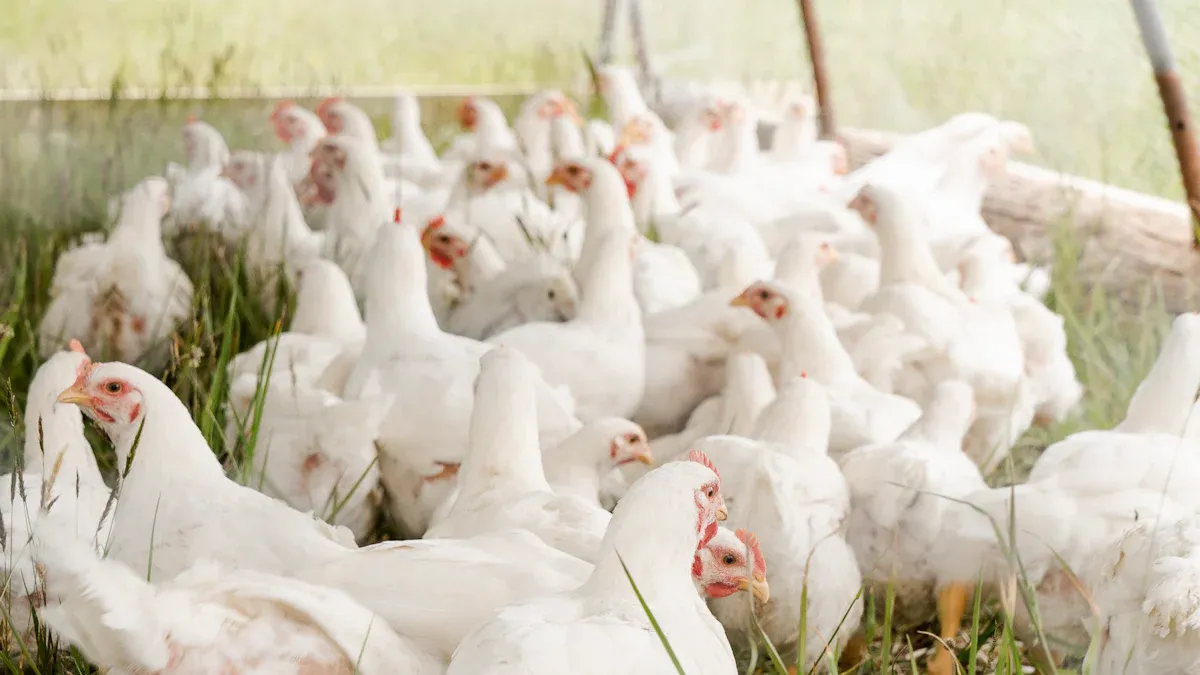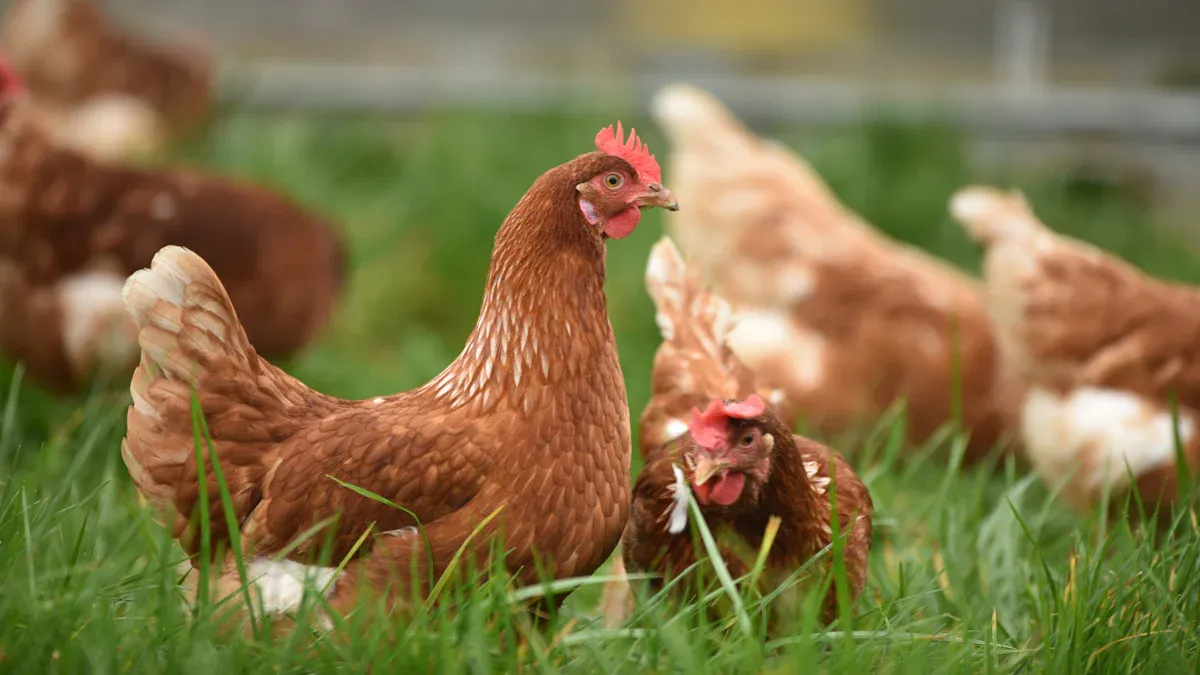Rising feed costs are squeezing your profits as a poultry farmer in South Africa. Did you know feed expenses make up about 70% of your production costs? With maize and soybean prices fluctuating, it’s no wonder you’re searching for alternatives. Mealworms for Poultry offer a game-changing solution. As a leading mealworm supplier, we provide a sustainable, cost-effective protein source to help you thrive.
Key Takeaways
- Mealworm protein helps poultry farmers save money on feed costs. It keeps profits steady even when maize and soybean prices go up.
- Using mealworms gives chickens great nutrition. This helps them grow faster and stay healthier while eating less food.
- Choosing mealworm protein is better for the environment. It uses less land and water and makes fewer harmful gases.
The Challenge of Rising Feed Costs

Impact of maize and soybean price volatility
You’ve probably noticed how unpredictable maize and soybean prices have become. Yellow maize prices, for instance, hit an all-time high of over R5000 in December 2023. That’s the highest in a decade! Soybean prices haven’t been any better. They’ve been bouncing up and down, but the overall trend shows they’re climbing. These fluctuations make it tough to plan your feed budget, leaving you vulnerable to sudden cost spikes.
Here’s the thing: the maize industry grew by 245.2% between 2010 and 2023, reaching R57.7 billion. Soybeans? They skyrocketed by 727.7% in the same period. While this growth might sound impressive, it’s a double-edged sword for poultry farmers like you. Rising prices mean higher feed costs, which eat into your profits.
How feed costs influence poultry production expenses
Feed costs are the backbone of your poultry operation. Did you know they account for about 70% of your total production expenses? Maize alone makes up roughly 60% of the feed. When maize prices rise, your production costs follow suit. This directly impacts your profit margins, making it harder to stay competitive.
The ripple effect doesn’t stop there. Higher feed costs often lead to increased poultry prices in the market. But here’s the catch: consumers may not always be willing to pay more, leaving you stuck in a financial squeeze.
The search for alternative protein sources
With feed costs soaring, you’re likely exploring alternatives. That’s where Mealworms for Poultry come in. They’re not just cost-effective; they’re also packed with nutrients that your birds need. Plus, they’re a sustainable option, reducing your reliance on traditional feed ingredients like maize and soybeans.
Switching to mealworm protein could be the game-changer you’ve been looking for. It offers a way to cut costs without compromising on quality, helping you navigate the challenges of rising feed prices.
Why Mealworms for Poultry is the Solution

Cost-effectiveness of mealworm protein
You’re always looking for ways to cut costs, right? Mealworms for Poultry offer a budget-friendly alternative to traditional feed proteins like maize and soybeans. They’re cheaper to produce because they need less land, water, and feed. Plus, they grow quickly and efficiently, which keeps production costs low.
Here’s the kicker: mealworms pack a punch when it comes to nutrition. This means you can use less feed while still giving your birds everything they need to thrive. Lower feed quantities mean lower expenses for you. And with mealworms producing fewer greenhouse gases, you’re not just saving money—you’re also contributing to a greener planet.
Nutritional benefits for poultry diets
Your birds deserve the best, and mealworms deliver. They’re loaded with high-quality protein, essential amino acids, and healthy fats. These nutrients are vital for your poultry’s growth, egg production, and overall health.
Mealworms for Poultry also improve feed conversion rates. This means your birds grow faster and healthier with less feed. It’s a win-win—you save on costs, and your poultry gets a balanced, nutrient-rich diet.
Sustainability and environmental advantages
Switching to mealworms isn’t just good for your wallet; it’s great for the environment too. Mealworms require significantly less land and water compared to traditional crops like maize and soybeans. They also produce fewer greenhouse gases, making them an eco-friendly choice.
As food security becomes a growing concern, mealworms offer a scalable and sustainable solution. By adopting this protein source, you’re not only future-proofing your farm but also contributing to a more sustainable agricultural system.
Adopting Mealworm Protein in South Africa
Farmer readiness and willingness to adopt
You might be wondering if South African farmers are ready to embrace mealworm protein. The good news is, many farmers are already exploring innovative ways to cut feed costs. Mealworms for Poultry are gaining attention because they’re affordable and easy to integrate into existing feed systems. Farmers who’ve tried them report better poultry health and lower expenses.
But adoption isn’t just about cost. It’s also about mindset. You may feel hesitant to switch from traditional feed ingredients like maize and soybeans. That’s normal. However, mealworms offer a proven track record in other countries, and early adopters in South Africa are seeing positive results.
Tip: Start small. Test mealworm protein on a portion of your flock to see the benefits firsthand.
Scalability of mealworm production
You might ask, “Can mealworm production meet the demand?” Absolutely. Mealworms are incredibly efficient to produce. They require less space, water, and feed compared to traditional crops. This makes scaling up production much easier.
Local suppliers are already ramping up operations to meet the growing interest. Some are even partnering with farmers to create decentralized production hubs. This means you could potentially grow your own mealworms, cutting costs even further.
Here’s a quick comparison:
| Factor | Mealworms | Maize/Soybeans |
|---|---|---|
| Land Requirement | Minimal | Extensive |
| Water Usage | Low | High |
| Production Time | Short | Long |
Regulatory and market considerations
Switching to mealworm protein isn’t just about production—it’s also about navigating regulations. South Africa’s agricultural authorities are increasingly supportive of alternative protein sources. Mealworms for Poultry meet safety and nutritional standards, making them a viable option for your farm.
Market acceptance is another key factor. Consumers are becoming more eco-conscious, and they’re likely to support sustainable farming practices. By adopting mealworm protein, you can position your poultry products as environmentally friendly, giving you a competitive edge.
Note: Stay updated on local regulations to ensure compliance when incorporating mealworms into your feed.
Mealworm protein is your answer to rising feed costs. It’s affordable, packed with nutrients, and eco-friendly. By switching to this sustainable option, you can stabilize costs, improve poultry health, and reduce your environmental footprint.
Why wait? Embrace mealworm protein today and secure a profitable, greener future for your farm!
FAQ
What makes mealworm protein better than traditional feed ingredients?
Mealworm protein is cost-effective, nutrient-dense, and eco-friendly. It reduces feed costs, improves poultry health, and has a smaller environmental footprint compared to maize or soybeans.
How can I start using mealworm protein on my farm?
Start small! Test mealworm protein on a portion of your flock. Monitor results like growth rates and health to see its benefits firsthand.
Is mealworm protein safe for poultry?
Yes, it’s completely safe. Mealworms meet nutritional and safety standards, ensuring your poultry gets high-quality feed without compromising their health or productivity.
Tip: Consult your local supplier for guidance on incorporating mealworm protein into your feed system.



